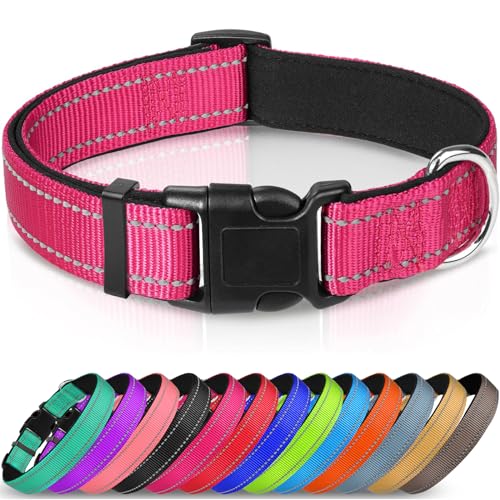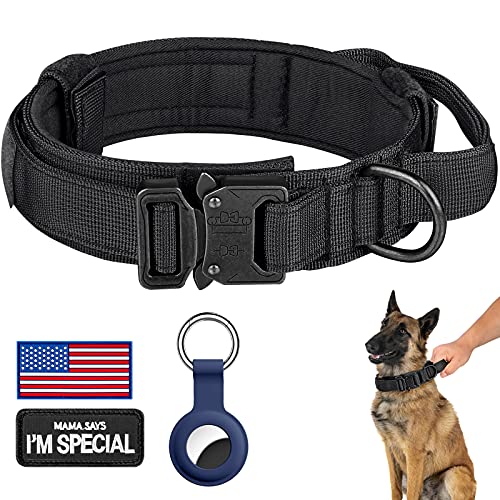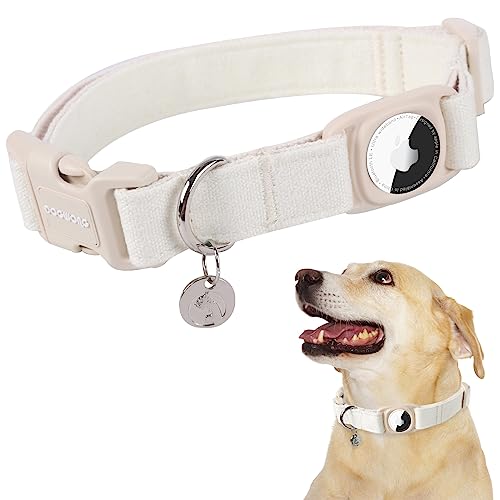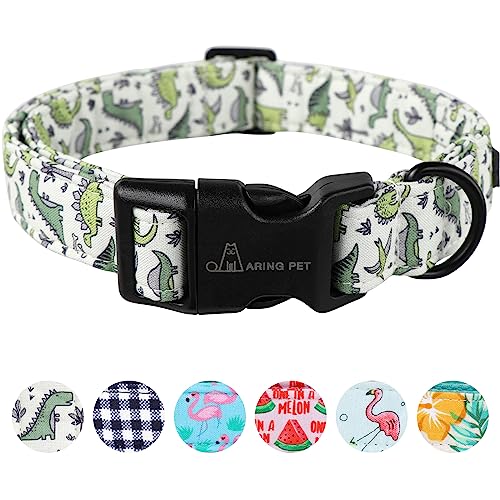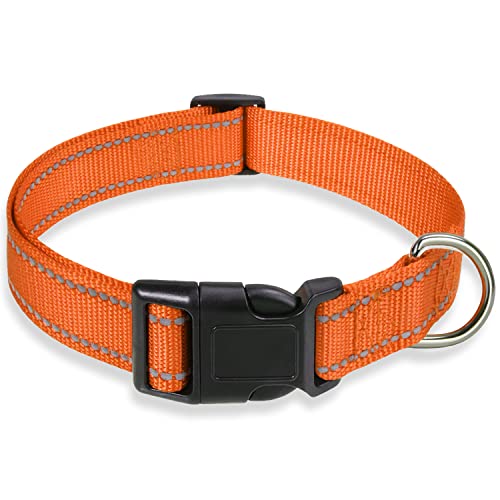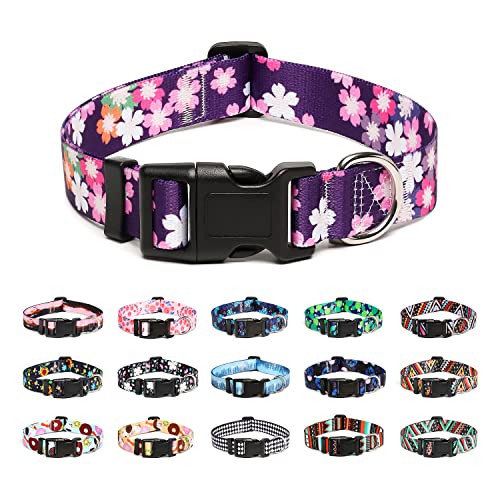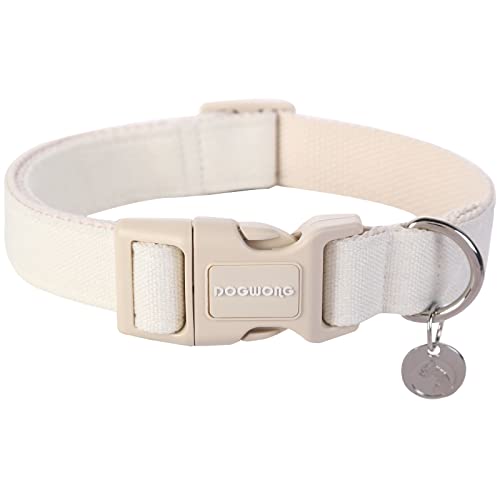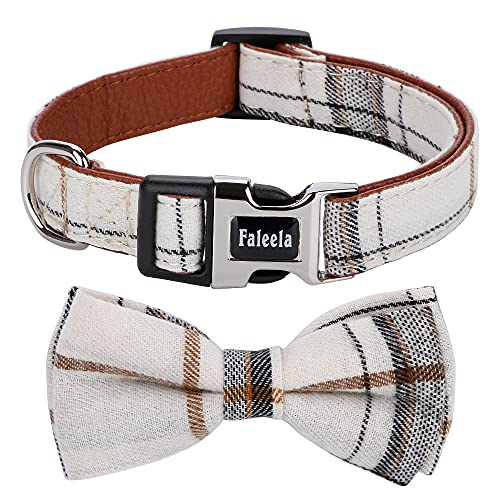Choosing the right size and style of collar for your dog may seem like a simple task, but it can actually make a significant difference in their comfort and well-being. Collars are not only a fashion statement for our furry friends but also serve as a crucial tool for controlling and identifying them. However, with so many options available in the market, it can be overwhelming to find the perfect fit for your dog. That’s where this article comes in! We will guide you through the process of selecting the right collar size and style for your canine companion, ensuring their safety and happiness.
Finding the ideal collar for your dog is essential because it directly impacts their comfort and safety during walks and other activities. A properly fitting collar prevents any discomfort or injury that may occur from an ill-fitting or inappropriate style. Additionally, collars play an important role in helping to identify your dog, with many featuring tags that display their name and contact information. This provides peace of mind in case your dog gets lost or accidentally wanders off. With the right collar, you can ensure that your beloved pet is both stylish and secure! Whether you have a small dog, a large breed, or something in between, we have got you covered with expert advice and tips to assist you in making the best decision for your furry companion.
Joytale Reflective Dog Collar,Soft Neoprene Padded Breathable Nylon Pet Collar Adjustable for Large Dogs,Hotpink,L
Function:
A dog collar serves a functional purpose, providing a means of identification and control for your pet. It should fit comfortably and securely around your dog’s neck, allowing you to attach a leash for walks or outings. The collar should also be adjustable to accommodate changes in your dog’s size as it grows.
For example, a collar with a D-ring attachment allows for easy leash attachment and ensures you have control over your dog’s movements. Additionally, some collars may come with added features such as reflective materials for improved visibility during nighttime walks.
Case studies have shown that using appropriately sized and styled collars can greatly contribute to the overall function and effectiveness of dog training and obedience.
Uses:
Choosing the right size and style of collar for your dog depends on its intended use. Different types of collars can serve various purposes, such as everyday wear, training, or specialized activities.
For instance, a traditional flat buckle collar is suitable for regular walks and general identification purposes. On the other hand, a martingale collar can be helpful for training, especially for dogs that tend to pull on the leash.
Some specific activities like hiking or water sports may call for specialized collars. Waterproof or quick-drying collars are ideal for water-based activities, while lightweight and durable collars are appropriate for outdoor adventures.
Design:
The design of a dog collar includes factors such as materials, hardware, and aesthetics. It’s crucial to consider the safety and comfort of your dog while choosing a design.
Collar materials can vary from nylon, leather, or fabric blends. Nylon is durable, easy to clean, and suitable for everyday wear. Leather collars offer a classic look but require more maintenance. Fabric blends provide a comfortable fit and come in various patterns and designs.
When it comes to hardware, ensure it is sturdy and secure. Metal buckles and D-rings are considered reliable choices. Avoid collars with easily breakable plastic components.
Build Quality:
The build quality of a dog collar determines its durability and longevity. Opting for high-quality collars is essential to ensure they can withstand the wear and tear of daily use.
Seams and stitching should be strong and reinforced to prevent fraying or unraveling. Additionally, the collar should have adjustable sizing options to accommodate your dog’s growth.
Examining customer reviews and testimonials can provide insights into the build quality of different collar brands and help you make an informed decision.
Primary Features:
Primary features to consider when choosing a dog collar include size, adjustability, and closure type.
Proper sizing is crucial to ensure the collar fits comfortably without causing discomfort or restricted breathing. Measure your dog’s neck circumference accurately and follow size guidelines provided by the manufacturer.
Adjustability allows you to adapt the collar to your dog’s changing size and ensures a secure fit throughout its growth stages.
The closure type can vary between buckle, snap, or quick-release mechanisms. Choosing the right closure depends on your dog’s behaviors and preferences. Quick-release buckles offer hassle-free removal, while snap closures can withstand more force.
Recommended dog collar
| Pros | Cons |
|---|---|
1. Tracking CapabilityThe dog collar includes GPS tracking technology, allowing pet owners to easily locate their dogs if they go missing. This feature provides peace of mind and helps ensure the safety of the pet. Impact on User Experience: The tracking capability enhances the user experience by providing a sense of security, as owners can promptly respond and prevent any potential harm or loss of their dogs. |
1. Limited Battery LifeThe collar’s GPS tracking functionality relies on battery power, which can drain relatively quickly depending on usage and the collar’s specific features. Impact on User Experience: While GPS tracking is beneficial, the limited battery life can inconvenience users who have to frequently recharge or change batteries. |
2. Training AidSome dog collars come with training features such as remote control vibration or mild electric stimulation. These aids can assist in training dogs to follow commands or discourage negative behavior. Impact on User Experience: The training aid functionality can improve the user experience by facilitating effective training sessions, resulting in better-behaved dogs and stronger bonds between pets and owners. |
2. Potential DiscomfortCollars with training features may cause discomfort to dogs if not used appropriately or if the intensity levels are set too high. It is crucial for owners to use these features responsibly and avoid causing unnecessary stress or pain. Impact on User Experience: If the collar leads to discomfort for the dog, it negatively impacts the user experience, potentially causing distress for both the pet and the owner. |
3. Safety FeaturesSome dog collars include reflective materials or LED lights, enhancing visibility during nighttime walks or in low-light conditions. These safety features can help prevent accidents and keep dogs and owners safe. Impact on User Experience: The inclusion of safety features significantly improves the user experience by providing increased visibility and reducing the risk of accidents or losing sight of the dog. |
3. Size LimitationsSome dog collars have size limitations and may not be suitable for all breeds or sizes of dogs. Owners need to ensure they select a collar that fits their dog comfortably and appropriately. Impact on User Experience: If the collar’s size limitations prevent owners from finding a suitable fit for their dog, it can lead to discomfort or ineffective usage, negatively impacting the user experience. |
Top 10 rated dog collar
Factors to Consider When Choosing a Dog Collar
When it comes to choosing a dog collar, there are several factors that you should take into consideration to ensure that you make an informed purchase decision. The right collar can not only provide comfort and safety for your furry friend but also reflect their unique style and personality. Here are some key factors to keep in mind:
Size and Fit
One of the most important factors to consider when choosing a dog collar is the size and fit. The collar should be neither too tight nor too loose. It should fit snugly around your dog’s neck, allowing for a two-finger gap between the collar and their skin. Measure your dog’s neck circumference accurately to ensure a proper fit. Consider adjustable collars that can be easily resized as your dog grows.
Material
The material of the dog collar plays a crucial role in its durability, comfort, and overall effectiveness. Common materials include nylon, leather, and chain. Nylon collars are lightweight and ideal for everyday use, while leather collars offer a classic and stylish look. Chain collars are often used for training purposes. Consider your dog’s specific needs and preferences to choose the most suitable material for their collar.
Style and Design
Dog collars come in a wide variety of styles and designs, allowing you to choose one that suits your dog’s personality and your personal taste. From vibrant colors to patterns and embellishments, there’s something for everyone. Reflective collars are a great choice for added visibility during nighttime walks. Additionally, consider if you want a collar with a buckle, snap, or quick-release feature for ease of use.
Hardware
The hardware on a dog collar, such as D-rings and buckles, should be sturdy and reliable. A D-ring is essential for attaching a leash or ID tags. Opt for high-quality hardware that can withstand your dog’s strength and activity level. Additionally, check if the buckles or closures are easy to use and secure to ensure that the collar stays in place.
Comfort and Safety
The comfort and safety of your dog should be a top priority when choosing a collar. Look for features such as padding or neoprene lining to prevent chafing and irritation. Avoid collars with rough or sharp edges that can cause discomfort. Safety features like breakaway or martingale collars are recommended for dogs prone to pulling or escaping. Always consider your dog’s breed, size, and behavior when selecting a collar.
Additional Features
Some dog collars offer additional features and functionality that may be useful for you and your dog. For example, GPS tracking collars can help you keep tabs on your dog’s whereabouts, while remote training collars can aid in obedience training. Consider if any of these additional features would benefit you and your dog’s lifestyle.
Remember to take your time and carefully evaluate different options before making your final decision. Consider your dog’s unique needs, lifestyle, and preferences. By choosing the right collar, you can ensure your dog’s comfort, safety, and style all in one.
Best choice for dog collar in 2023
Joytale Reflective Dog Collar,Soft Neoprene Padded Breathable Nylon Pet Collar Adjustable for Large Dogs,Hotpink,L
$8.99
DAGANXI Tactical Dog Collar, Adjustable Military Training Nylon Dog Collar with Control Handle and Heavy Metal Buckle for Medium and Large Dogs, with Patches and Airtags Case (L, Black)
$13.99
DOGWONG Airtag Cotton Hemp Dog Collar, Heavy-Duty Dog Collar with Airtag Holder White Dog Collar Durable Natural Fabric Pet Dog Collar Cute Puppy Necklace for Small Medium Large Dog
How to Find and Choose the Right Dog Collar on Amazon
1. Determine the Correct Size
Before browsing dog collars on Amazon, measure your dog’s neck size. Use a flexible measuring tape or a piece of string to measure around the base of their neck, ensuring it is snug but not too tight. Note down the measurements in inches or centimeters for reference when selecting a collar.
On Amazon, most dog collar listings provide a size chart or a recommended weight range, which can guide you in choosing the correct size for your dog’s neck. Additionally, consider adjustable collars that provide some flexibility in case your dog’s weight fluctuates.
2. Select the Appropriate Material
Dog collars are available in various materials such as nylon, leather, or fabric. Each material has its advantages and considerations:
- Nylon collars are durable, easy to clean, and come in a wide variety of colors and patterns.
- Leather collars are stylish, sturdy, and often more comfortable for dogs with sensitive skin.
- Fabric collars are lightweight and come in a range of designs, ideal for fashion-conscious dog owners.
Consider your dog’s specific needs, such as any allergies or skin sensitivities, as well as your preferences when selecting the material of the collar.
3. Decide on the Type of Closure
There are different types of closures or buckles for dog collars. The most common options include:
- Quick-release buckle: These are convenient and easy to fasten and unfasten, providing a secure closure.
- Traditional buckle: These require a bit more effort to secure but are generally sturdier.
- Martingale closure: This type of closure is ideal for dogs prone to slipping out of regular collars as it tightens when the dog pulls, preventing escape.
Consider your dog’s behavior, size, and any specific requirements when determining the most suitable closure type for their collar.
4. Take Note of Additional Features
Some dog collars come with additional features that may be beneficial for your pup. These may include:
- Reflective strips or tags for enhanced visibility during low-light walks.
- D-ring or buckle for attaching ID tags and leashes.
- Padded interior for added comfort, especially for dogs with delicate necks or those prone to pulling.
- Waterproof or water-resistant material for dogs who love splashing in puddles or swimming.
Consider your dog’s specific needs and lifestyle when deciding which additional features will be most beneficial.
Common Issues Related to Dog Collars
1. Collar Fit and Size Adjustments
Ensuring the proper fit of a dog collar is crucial for comfort and safety. If the collar is too loose, the dog may slip out of it, while a collar that is too tight can cause discomfort or restrict their breathing. Regularly check your dog’s collar fit, particularly as they grow or if they gain or lose weight. If necessary, adjust the collar size or consider purchasing an adjustable collar.
2. Skin Irritation or Allergies
Some dogs may develop skin irritation or allergies from certain materials used in dog collars. If your dog experiences redness, itching, or any other signs of discomfort around their neck, try switching to a hypoallergenic material like leather or selecting collars with padded interiors. Consult with your veterinarian if the issue persists.
3. Chewers or Destructive Dogs
If your dog is prone to chewing or destructive behavior, consider purchasing a chew-resistant or reinforced collar. These collars are designed with durable materials or added reinforcement to withstand the chewing and biting habits of certain dogs.
4. Cleaning and Maintenance
Regularly clean your dog’s collar to prevent dirt, bacteria, and odors from accumulating. Check the manufacturer’s instructions for the recommended cleaning method based on the collar’s material. Some collars can be machine-washed, while others may require handwashing or wipe-downs with pet-safe cleaning products.
Cheapest alternatives for dog collar
## FAQ
### What size dog collar should I choose for my dog?
The size of the dog collar depends on the breed and size of your dog. It is recommended to measure your dog’s neck circumference before purchasing a collar. Most collar sizes are adjustable and provide a size range, so choose a collar that will fit comfortably when adjusted to the appropriate size for your dog’s neck.
### Are these collars suitable for puppies?
Yes, these collars are suitable for puppies. However, it is important to choose a collar that is specifically designed for puppies to ensure a proper fit. Puppies grow quickly, so adjustable collars are recommended to accommodate their growing necks. It is also advisable to check the collar frequently and adjust it as needed to ensure a comfortable fit.
### Can I use these collars for training purposes?
Yes, these collars can be used for training purposes. Some collars are specifically designed for training and may have additional features, such as a remote control or different modes of stimulation. However, it is important to use any training collar responsibly and according to the instructions provided by the manufacturer. Always consult with a professional dog trainer for guidance on the proper and humane use of training collars.
### Are these collars safe for my dog?
Yes, these collars are designed with the safety and comfort of your dog in mind. They are made from high-quality materials that are durable and resistant to wear and tear. However, it is important to regularly check the collar for any signs of damage or wear and replace it if necessary. Additionally, it is crucial to ensure that the collar is properly fitted and not too tight, as this can cause discomfort or injury to your dog.
### Can I personalize or customize these collars?
Some of these collars offer options for personalization or customization. They may have removable or interchangeable decorative elements or come in various colors and designs to suit your preferences. However, it is important to ensure that any customization does not compromise the functionality or safety of the collar. Always follow the manufacturer’s instructions and guidelines when customizing the collar.
### How do I clean these collars?
The cleaning instructions for these collars may vary depending on the materials used. It is recommended to refer to the manufacturer’s instructions for specific cleaning guidelines. In general, most collars can be cleaned by wiping them with a damp cloth or using a mild soap solution. Avoid using harsh chemicals or abrasive cleaners that may damage the collar. Allow the collar to air dry completely before putting it back on your dog.
In conclusion, choosing the right size and style of dog collar is crucial for ensuring your furry friend’s comfort and safety. By carefully considering their measurements and specific needs, you can make a valuable choice that will enhance your dog’s overall wellbeing. The benefits of selecting the perfect collar include proper identification, control during walks, and prevention of potential injuries. With a wide variety of sizes and styles available on the market, you can easily find a collar that suits both your dog’s preferences and your desired aesthetic. Remember, a properly fitting collar ensures your dog’s happiness and allows you to embark on countless adventures together with peace of mind.




